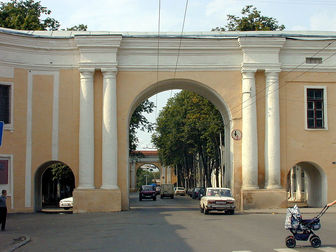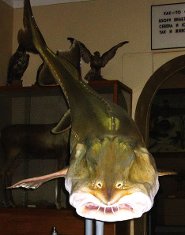Kaluga
Kaluga caviar comes from the Kaluga River Beluga sturgeon.

Original source: walks.ru Author Alexei Troshin (Алексей Трошин) This file comes from walks.ru (Прогулки по России) and is copyrighted. The original file location is
Author: Alexei Troshin (Алексей Трошин) This file comes from walks.ru (Прогулки по России) and is copyrighted. The original file location is
Permission: GNU Free Documentation License
The Kaluga lives in the demersal, anadromous, freshwater, brackish, marine, depth range 0 - 50 m environment.
The Kaluga is classified as Endangered (EN), considered to be facing a very high risk of extinction in the wild.
Kaluga - The World's Largest Freshwater Fish
 The river beluga or kaluga (Huso dauricus) is thought to be the largest freshwater fish in the world, although one female beluga caught in 1824 was larger and heavier. But on average, kaluga grow larger than beluga. However, the point may soon be moot as both the kaluga and the beluga are critically endangered. Adult kaluga are only found in the freshwater Amur River basin as they have been fished to extinction in the Argun River. Juveniles live in salt water from the Sea of Okhotsk in Russia down to the Japanese island of Hokkaido.
The river beluga or kaluga (Huso dauricus) is thought to be the largest freshwater fish in the world, although one female beluga caught in 1824 was larger and heavier. But on average, kaluga grow larger than beluga. However, the point may soon be moot as both the kaluga and the beluga are critically endangered. Adult kaluga are only found in the freshwater Amur River basin as they have been fished to extinction in the Argun River. Juveniles live in salt water from the Sea of Okhotsk in Russia down to the Japanese island of Hokkaido.
Kaluga are heavily poached for their roe or caviar, which is considered a delicacy. Just one ounce of kaluga caviar fetches prices of $150 (US). kaluga caviar tastes very similar to beluga caviar. Adult females can produce up to 44 pounds (20 kilograms) of caviar. The fish must be killed in order to extract the caviar. Increasing pollution in the Amur River is also killing kaluga of all ages and sizes.
Physical Description
Adult kaluga fish resemble sharks, with elongated bodies and wide mouths with needle-like teeth. They lack a prominent dorsal fin. Instead, they have a row of small, pyramid-shaped bony fins going down the back of their spines. This row can break the surface of the water similar to a shark’s dorsal fin. They have pale bellies and greenish-tan upper bodies with a yellow tinted tail. Adults can grow as long as 18.6 feet (5.6 meters) and weigh up to 2205 pounds (1,000 kilograms), although many are killed before they reach this monster size.
Adults possess very unusual heads. Their eyes are tiny in comparison to the rest of the body and places in the center of the massive, ridged head. Due to the location on the front of the head instead of the sides, kaluga may have bifocal vision. Their heads end in a pointed snout.
Life Cycle and Behavior
Kaluga hatch in shallow gravel beds in freshwater estuaries of the Amur River. Their parents play no part in raising their young. After growing in their eggs from 83 to 295 hours, fry hatch with a yolk sac that keeps them fed for 8 or 9 days. Then they must hunt. Juveniles fend for themselves, eating tiny zooplankton, insects and shrimp. The current carries the young fish out to sea, where they mature until they are ready to breed around 10 to 14 years of age. Females can only breed every four years.
Adult kaluga possess prodigious appetites. They eat pike, carp, herring, chum salmon, keta and just about any other fish or shellfish that can fit in their mouths. kaluga spawning season begins in May and ends in July. Adults travel in small groups of 3 to 20 individuals to the shallow gravel beds to spawn. If a fish is too large, they can die from getting stuck in such shallow water. kaluga can spawn with another species of fish, the Amur sturgeon. With luck, a kaluga can live up to 55 years.
Picture of the kaluga by Eliezg, licensed under GFDL
Common names
Amurinkitasampi in Finnish (suomen kieli)
Cá tầm Kaluga in Vietnamese (Tiếng Việt)
Dauria-chôzame in Japanese (日本語)
Daūrinis eršketas in Lithuanian (lietuvių kalba)
Great Siberian sturgeon in English
Huso sturgeon in English
Kaluga in Czech (česky)
Kaluga in English
Kaluga in German (Deutsch)
Kaluga in Polish (polski)
Kaluga in Russian (русский язык)
Kaluga-Hausen in German (Deutsch)
Kaluuga in Estonian (Eesti keel)
Kaługa (ryba) in Polish (polski)
Manchurian sturgeon in English
Østsibirisk hus in Danish (dansk)
Siberian huso sturgeon in English
Vyza malá in Czech (česky)
Vyza sibiřská in Czech (česky)
калуга in Russian (русский язык)
Калуга (риба) in Bulgarian (български език)
Калуга (рыба) in Russian (русский язык)
鰉 in Mandarin Chinese
鳇 in Mandarin Chinese


Family : Acipenseridae
Genus : Huso
Species : Huso dauricus
Authority : Georgi, 1775
